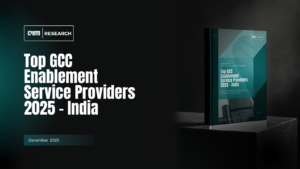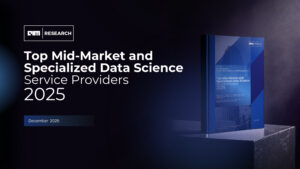In today’s rapidly evolving landscape, mastering the art of problem-solving with data analytics and AI is paramount for organizations seeking to stay ahead. This strategic approach involves harnessing the power of advanced technologies to unlock valuable insights and drive informed decision-making. By integrating data-driven methodologies with strategic thinking, businesses can effectively tackle complex challenges and uncover new opportunities for growth and innovation. Embracing this approach enables organizations to optimize processes, enhance efficiency, and remain competitive in an increasingly data-driven world.
We had a roundtable discussion on the topic with a set of experienced and distinguished leaders in the industry. The session was moderated by Deepika Kaushal, Head-Everyday AI & Digital analytics at Piramal Capital & Housing Finance, along with panelists Biswanath B, Director of Data at Kredivo Group, Bhaskar Roy, Client Partner APAC and Bangalore Center Head at Fractal, Preeti SP, Digital Technology Director, Advanced Analytics at GE Appliances, a Haier company and Itti Singh, Head of Analytics Advisory, DLL at Landmark.
Challenges in Deploying AI Solutions in Large Organizations
In my experience, I’ve witnessed numerous teams coming together when deploying something meaningful in terms of AI consumption. Problem-solving is one aspect, but adapting the end consumer to it is a whole different ball game. Building a sustainable solution that continuously learns or receives continuous feedback is essential. Additionally, ensuring that it scales up well according to your plans adds to the challenge. Combining these aspects can be challenging because it’s comparatively easier to solve any analytical problem in a presentation compared to when it’s consumed in real-time on a tech journey.
I think when it comes to problem-solving and bringing people together, especially within a very large organization where various teams operate independently, implementing something that requires a high degree of cross-collaboration can be challenging. It might not be on everyone’s radar, and they may not prioritize it. While the CEOs or CXOs may be aligned with the implementation of a particular problem, all the teams below them might not be aligned.
– Deepika Kaushal, Head-Everyday AI & Digital analytics at Piramal Capital & Housing Finance
Navigating Risk and Analytics: Key Challenges and Solutions
In the burgeoning BNPL (Buy Now, Pay Later) and in general retail lending sector, our paramount challenge centers around adeptly managing risk. This entails devising strategies for risk mitigation, particularly when catering to customer segments characterised by limited banking access or the absence of credit cards. Operating within such a demographic inherently escalates the risk quotient. It becomes imperative to ensure the robustness and adaptability of our models. Thus, a critical issue we grapple with is the dual objective of refining our risk models for optimal performance, while concurrently upholding ethical standards. We are committed to ensuring that our models neither discriminate against specific demographics nor over-leverage others. A significant portion of our problem-solving endeavours is directed towards leveraging diverse, modern data sources, managing data costs efficiently, and facilitating informed risk-related decision-making.
Apart from the novel external data, using various tools and techniques effectively is also extremely important to reach to the risk decision making process faster and more accurately. While the proficiency of our risk models is foundational, we must not overlook the emerging challenges in fraud detection. In this domain, the emphasis shifts towards employing sophisticated unsupervised learning techniques and pattern recognition algorithms, capable of analysing both structured (e.g. transaction data) and unstructured (e.g. image) data. The continuous feedback and iterative improvement of these models are vital components of our analytical arsenal. These methodologies epitomise the “Science” of problem-solving through data analytics.
Conversely, numerous scenarios rely heavily on the “Art” of problem-solving. This approach is fundamentally about tackling business challenges from first principles. It entails a deep dive into understanding the problem, posing pertinent questions at various levels, meticulously exploring the data, formulating hypotheses, and validating these through data. This iterative process continues until we unearth actionable insights. This method is particularly prevalent in addressing issues related to growth, marketing, customer engagement etc. It necessitates extensive collaboration with business teams and iterative data analysis, all the while ensuring alignment with the core business objectives.
In summary, navigating the complexities of risk and analytics in the BNPL industry requires a balanced amalgamation of scientific rigor and artful exploration. By marrying advanced data analytics and AI with a principled approach to problem-solving, we can not only manage risk more effectively but also drive sustainable growth and innovation.
– Biswanath B, Director of Data at Kredivo Group
Strategic Problem-Solving and Gen AI Perspectives
As we think about the problem itself, it’s crucial to ask the right questions upfront. Now, the questions can follow different frameworks. The one that I personally like the most is: What is the problem that you are facing? While the client might elucidate on what the problem they are facing today in terms of metrics they are looking at or other observations in the business, the next question is very important: What does it change for your business? Continue asking that until you are able to gain clarity on the core issue you’re trying to solve. Because most often than not, as I’m sure all of us have seen, what comes out as the first problem is usually just what is on the surface. You need to keep unpeeling those layers of the onion, as I love to call it, until you get to the core of exactly what you want to solve for, and then go about solving for it. You can look at different algorithms, you can look at different types of data to make your signals stronger, but getting to that core problem by asking those right questions upfront and ensuring that you are keeping the customer at the center is crucial. Because even with those questions, a lot of times the customer gets missed out because each decision-maker is actually looking at probably their own silos and not linking it back to the larger business. So, helping them do that and then solving for the right problems is a good start.
A lot of times, what gets bandied about as Gen AI is actually a wrapper on the more traditional ways of doing things, and we should ideally try to stay away from that as practitioners. We should also educate people around us. In my mind, as I think about Gen AI, it is a classical way of addressing problems which are either very time-intensive, like the research work in Pharma and Life Sciences, so that you can reduce cycle times in those industries. This can actually bring down the opportunity cost of new drug discovery and related activities. Alternatively, you can apply it to purely creative fields where, again, cycle times tend to be very high, and you can dramatically improve productivity by bringing in Gen AI-enabled tools. Most other use cases, at least today, given the kind of data we work with and the business scenarios we encounter, are actually better served by more traditional analytics, machine learning, or even more traditional AI, if I may call it that.
– Bhaskar Roy, Client Partner APAC and Bangalore Center Head at Fractal
The Dynamic Landscape of AI
Defining the problem statement isn’t always straightforward in my experience with AI. It takes true collaboration and brainstorming between Business and IT groups to understand what AI can offer technologically and arrive at real business use case with benefit quantification. For instance, when clients or stakeholders request a report, they understand the utility of the report itself but might not fully understand what AI can bring to the table. In my close to two decades of experience in IT, I’ve found that collaboration starts by engaging in extensive discussions on arriving at right use cases, followed by cross collaborative IT group efforts to consolidate necessary data into one platform and enable AI capability offerings on top of that.
The outcomes of various AI projects could vary. They could result in a financial gain, an improvement in customer experience, increased productivity, or enhanced business efficiency.
With the advent of Gen AI, the landscape has evolved even further. Now, business groups have the capability to leverage AI in various ways independently. Democratization of AI occurs at different levels. Based on Organizational data platform maturity and business use case, it is possible to enable Gen AI offerings across the board and also engage and partner with IT teams on complex use cases. Collaboration is key from day one until the final implementation of a use case, involving not just the business stakeholders but also internal departments and every relevant party.
On both sides of the world, we’ve witnessed evolution. We saw various Era’s in AI – starting with machine learning, then delved into deep learning. Now, we’re transitioning into Gen AI, and undoubtedly, another Era will emerge soon. Overall, these are exciting times for AI leaders like us, as it keeps us on our toes, continuously learning about the latest advancements. It’s an interesting and increasingly exhilarating journey with time.
– Preeti SP, Digital Technology Director, Advanced Analytics at GE Appliances, a Haier company
Reflections on Effective Problem-Solving and the Role of Gen AI
I think one of the most interesting things was that as we started asking the right questions, we actually understood that there is a problem in a) untapped potential that we have not yet exploited, and b) even if we were to exploit this potential, there are certain problems in the way. We are actually servicing these customers, which need to be addressed.
The toughest part is really ensuring that you solve the problem and that people are actually using what you develop. Asking the right questions to ensure that a lot of those projects actually did solve some business problems is crucial.
I want to say that the art of problem-solving is not always just about data mining and building fancy algorithms. Sometimes, it’s actually about putting yourself in the shoes of the real customer. Also, remember it is the art of problem-solving; you’re not talking about the science of problem-solving. It was the art piece or the creative conversations that we had with all of the teams that actually got all of us thinking about what we need to solve.
Along the way, what Gen AI has really helped us do is think beyond the current possibilities of solving a particular problem. From the point of how it can supercharge our own algorithms and make them better to how we present it to the end user, it’s helped us really think about how the end user actually uses our information. Can we make that better? Also, in terms of the inputs, what inputs can we possibly take and how much more data can we bring into our solutions? With this, there are a lot of possibilities that are being discussed.
There are some traditional things which still work. There’s a pure art of problem-solving; don’t forget that we still have to ask the right questions. We still have to find the right data. Nothing in the world is going to find that data for you. We still have to go find that data and build your algorithm, and then that’s where you can actually bring these powerful technologies into play. Give or take another year, where this actually starts pumping out actual business ROI.
Gen AI is another tool; it is a very strong tool, and it’s a tool that’s meant for user experience. Gen AI is just another tool that’s come into my toolbox to really make my solutions look complete and ready for the end users.
– Itti Singh, Head of Analytics Advisory, DLL at Landmark





